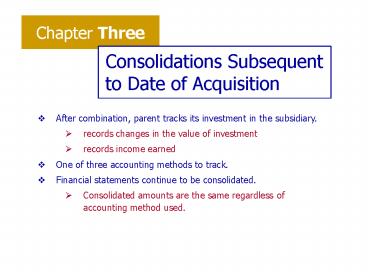Chapter Three PowerPoint PPT Presentation
1 / 25
Title: Chapter Three
1
Chapter Three
Consolidations Subsequent to Date of Acquisition
- After combination, parent tracks its investment
in the subsidiary. - records changes in the value of investment
- records income earned
- One of three accounting methods to track.
- Financial statements continue to be consolidated.
- Consolidated amounts are the same regardless of
accounting method used.
2
Cost Method
- Investment at original cost.
- Dividends recorded as income.
Equity Method
- Income accrued when earned by subsidiary.
- Dividends reduce value of investment.
- Amortization of excess of cost over book value.
Partial Equity Method
- Equity method without last step.
3
Exercise 3-31
- 2000 Palm acquires 100 of Storm.
Excess Annual Cost Amortization
Land Equipment Formula Total
4
- 2004 Palm receives dividend from Storm.
- 2004 Palm records income of Storm less extra
amortization.
5
(S)
Entry S eliminates beginning balance of R/E.
6
(A)
(A)
Adjusts for excess over book value less prior yr.
amortization. 5 ( 4 x 1 )
(A)
20 ( 4 x 1 )
7
(I) 66
(S)
Entry I eliminates income accrual.
8
(D) 40
(I) 66
(A)
(A)
Entry D to eliminate dividends.
(A)
9
(E) 1
(E) 1
(I) 66
(S)
(D) 40
Entry E records the extra amortization for
current period.
10
(D) 40
(I) 66
(A)
(A)
(E) 1
(A)
(E) 1
11
Differences Across Methods
Equity
Cost
Partial Equity
Cost records dividends as income
Divid Income
Partial Equity ignores extra amortizations.
12
Equity
Cost
Partial Equity
Cost Investment remains at original cost.
Partial Equity Investment doesnt include extra
amortizations.
13
Cost
(S)
(C)
Entry C adjusts Palms beginning R/E.
14
Cost
(S)
(C)
(A)
(A)
(A)
(A)
Adjustments (S) and (A) are the same as with the
equity method.
(S)
(S)
15
Cost
(I)
(S)
(C)
(I)
Entry I eliminates dividend income (Entry D not
needed).
16
Cost
(E) 1
(E) 1
(I)
(S)
(C)
(261)
(I)
Entry E is the same as before.
17
Cost
(S)
(C)
(A)
(A)
(A)
(E) 1
(A)
(E) 1
(S)
(S)
(745)
18
Partial Equity
(C)
(S) 98
Entry C adjusts Palms beginning R/E.
19
Partial Equity
(C)
(S) 163
(A) 27
(A) 10
(A) 1
(A) 16
Adjustments (S) and (A) are the same as with the
equity method.
(S) 60
(S) 5
20
Partial Equity
(I)
(C)
(S) 98
Entry I affects same accounts as equity (but
different in amount).
21
Partial Equity
(C)
(D)
(S) 163
(A) 27
Entry D to eliminate dividends.
(I)
(A) 10
(A) 1
(A) 16
(S) 60
(S) 5
22
Partial Equity
(E) 1
(E) 1
(I)
(C)
(S) 98
(261)
(D)
Entry E records the extra amortization for
current period.
23
Partial Equity
(C)
(D)
(S) 163
(A) 27
(I)
(A) 10
(A) 1
(E) 1
(E) 1
(A) 16
(S) 60
(S) 5
(745)
24
Equity
Cost
Partial Equity
Prob 3-18
Differences in income and the investment account.
25
Equity
Cost
Partial Equity
Prob 3-21
Differences in income and the investment account.

